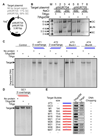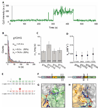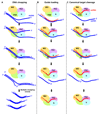Autonomous Generation and Loading of DNA Guides by Bacterial Argonaute
- PMID: 28262506
- PMCID: PMC5779613
- DOI: 10.1016/j.molcel.2017.01.033
Autonomous Generation and Loading of DNA Guides by Bacterial Argonaute
Abstract
Several prokaryotic Argonaute proteins (pAgos) utilize small DNA guides to mediate host defense by targeting invading DNA complementary to the DNA guide. It is unknown how these DNA guides are being generated and loaded onto pAgo. Here, we demonstrate that guide-free Argonaute from Thermus thermophilus (TtAgo) can degrade double-stranded DNA (dsDNA), thereby generating small dsDNA fragments that subsequently are loaded onto TtAgo. Combining single-molecule fluorescence, molecular dynamic simulations, and structural studies, we show that TtAgo loads dsDNA molecules with a preference toward a deoxyguanosine on the passenger strand at the position opposite to the 5' end of the guide strand. This explains why in vivo TtAgo is preferentially loaded with guides with a 5' end deoxycytidine. Our data demonstrate that TtAgo can independently generate and selectively load functional DNA guides.
Keywords: DNA chopping; RNA interference; TtAgo; ago; guide generation; guide loading; pAgo; prokaryotic argonaute; siDNA; small interfering DNA.
Copyright © 2017 Elsevier Inc. All rights reserved.
Figures







Similar articles
-
Effects of Argonaute on Gene Expression in Thermus thermophilus.PLoS One. 2015 Apr 22;10(4):e0124880. doi: 10.1371/journal.pone.0124880. eCollection 2015. PLoS One. 2015. PMID: 25902012 Free PMC article.
-
DNA-guided DNA interference by a prokaryotic Argonaute.Nature. 2014 Mar 13;507(7491):258-261. doi: 10.1038/nature12971. Epub 2014 Feb 16. Nature. 2014. PMID: 24531762 Free PMC article.
-
Thermus thermophilus Argonaute Functions in the Completion of DNA Replication.Cell. 2020 Sep 17;182(6):1545-1559.e18. doi: 10.1016/j.cell.2020.07.036. Epub 2020 Aug 25. Cell. 2020. PMID: 32846159 Free PMC article.
-
Understanding the core of RNA interference: The dynamic aspects of Argonaute-mediated processes.Prog Biophys Mol Biol. 2017 Sep;128:39-46. doi: 10.1016/j.pbiomolbio.2016.09.008. Epub 2016 Sep 30. Prog Biophys Mol Biol. 2017. PMID: 27697475 Review.
-
A long look at short prokaryotic Argonautes.Trends Cell Biol. 2023 Jul;33(7):605-618. doi: 10.1016/j.tcb.2022.10.005. Epub 2022 Nov 22. Trends Cell Biol. 2023. PMID: 36428175 Review.
Cited by
-
Accommodation of Helical Imperfections in Rhodobacter sphaeroides Argonaute Ternary Complexes with Guide RNA and Target DNA.Cell Rep. 2018 Jul 10;24(2):453-462. doi: 10.1016/j.celrep.2018.06.021. Cell Rep. 2018. PMID: 29996105 Free PMC article.
-
Argonaute with stepwise endonuclease activity promotes specific and multiplex nucleic acid detection.Bioresour Bioprocess. 2021 Jun 11;8(1):46. doi: 10.1186/s40643-021-00401-6. Bioresour Bioprocess. 2021. PMID: 38650261 Free PMC article.
-
DNA targeting and interference by a bacterial Argonaute nuclease.Nature. 2020 Nov;587(7835):632-637. doi: 10.1038/s41586-020-2605-1. Epub 2020 Jul 30. Nature. 2020. PMID: 32731256
-
Unexpected binding behaviors of bacterial Argonautes in human cells cast doubts on their use as targetable gene regulators.PLoS One. 2018 Mar 27;13(3):e0193818. doi: 10.1371/journal.pone.0193818. eCollection 2018. PLoS One. 2018. PMID: 29584750 Free PMC article.
-
Profiling Thermus thermophilus Argonaute Guide DNA Sequence Preferences by Functional Screening.Front Mol Biosci. 2021 Apr 29;8:670940. doi: 10.3389/fmolb.2021.670940. eCollection 2021. Front Mol Biosci. 2021. PMID: 33996915 Free PMC article.
References
-
- Adams PD, Grosse-Kunstleve RW, Hung LW, Ioerger TR, McCoy AJ, Moriarty NW, Read RJ, Sacchettini JC, Sauter NK, Terwilliger TC. PHENIX: building new software for automated crystallographic structure determination. Acta Crystallogr D. 2002;58:1948–1954. - PubMed
-
- Best RB, Zhu X, Shim J, Lopes PE, Mittal J, Feig M, Mackerell AD., Jr Optimization of the additive CHARMM all-atom protein force field targeting improved sampling of the backbone phi, psi and side-chain chi(1) and chi(2) dihedral angles. Journal of chemical theory and computation. 2012;8:3257–3273. - PMC - PubMed
MeSH terms
Substances
Grants and funding
LinkOut - more resources
Full Text Sources
Other Literature Sources

